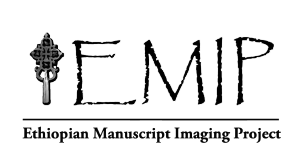The Digital Fingerprints of the Phenomenon of Textual History
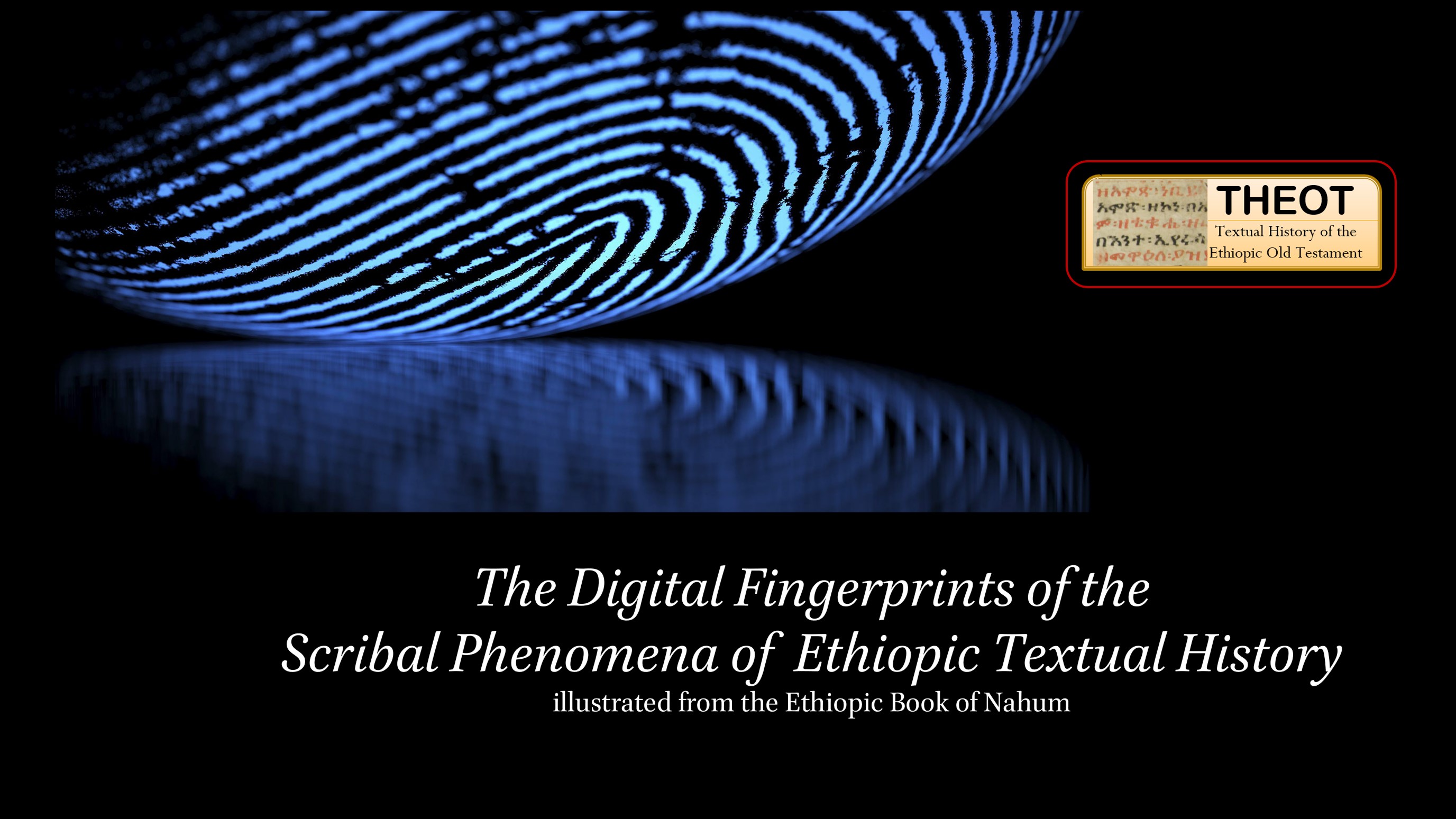
|
Introduction - The phenomenon of “digital fingerprints” is a necessary corollary of the alignment
of texts into columns based on shared root. See video
Aligning Aggregated Text.
This is grounded in the principle of the separability of the structural and semantic aspects of language.
See video
How and Why Statistical Profiles Work for Textual History.
It is also grounded on the principles of statistical probability. See video
Samples, Populations, and Textual History.
|
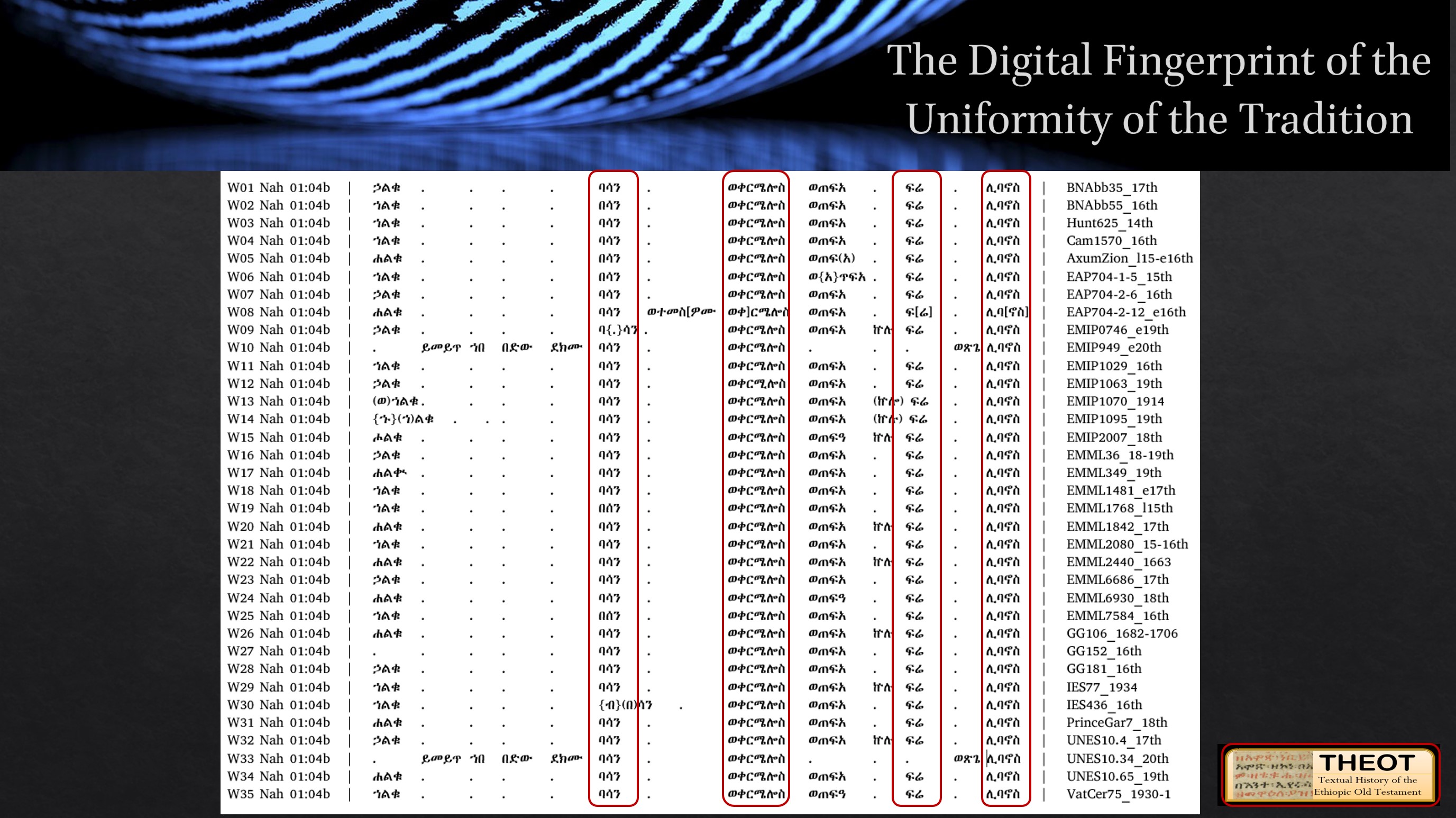
|
Uniformity of the Tradition - This is the digital fingerprint where everyone does the same thing. The columns with red boxes around them have this look. The column to the right of the second red box from the left is nearly uniform. There are only two manuscripts that have a minus where all the others have the word in this column. Eventually, we learned that these two manuscripts—UNESCO 10.34 and EMIP 949—were witnesses to a minor recension, the “Latin Vorlage” text form, a new translation of the text into Ge’ez, but based on the Latin Vulgate. The rest of the tradition is uniform at this point. |
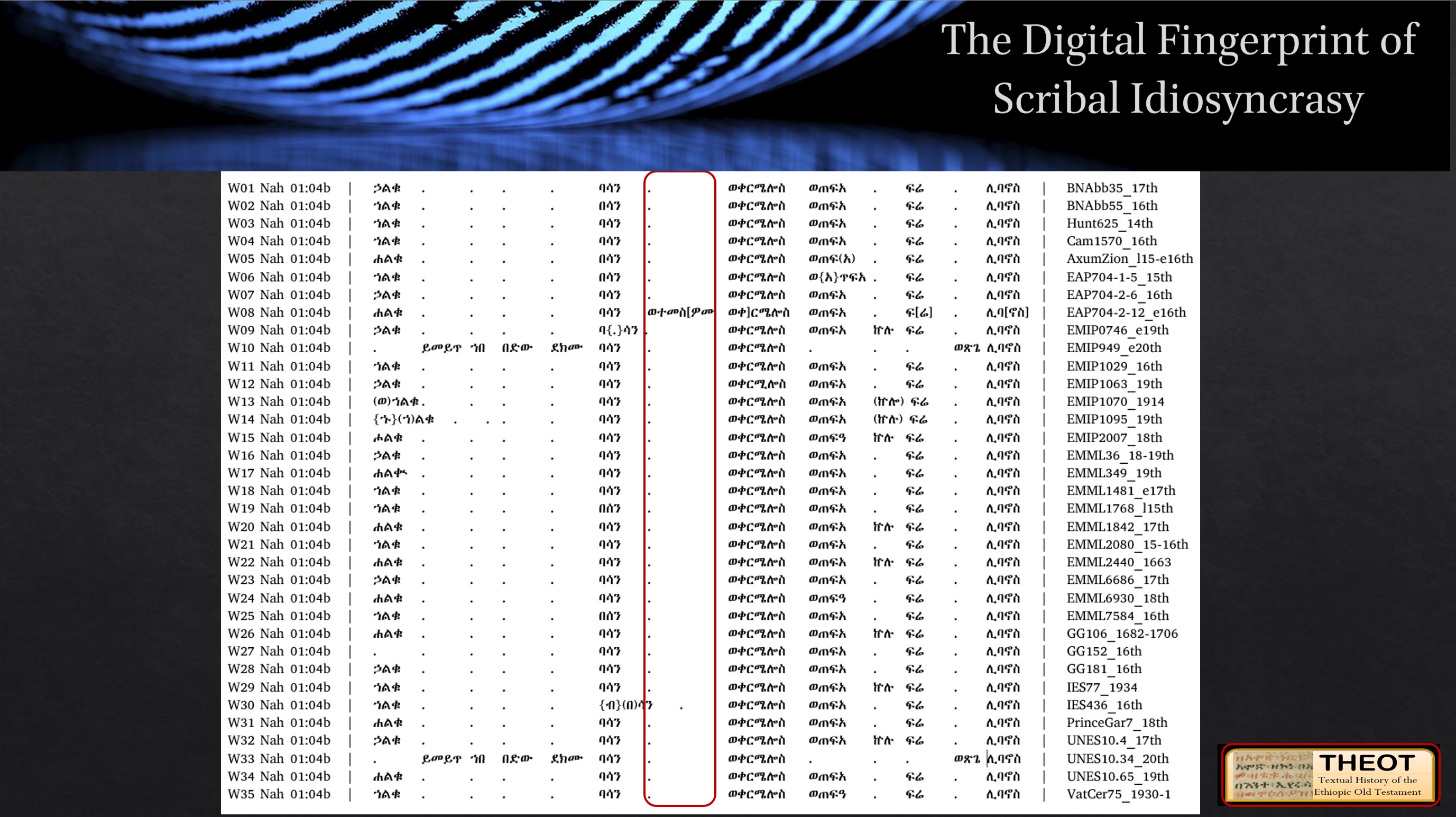
|
Scribal Idiosyncrasy - We define an act of scribal idiosyncrasy as any column in which one and only one manuscript varies from everyone else. Where the scribe has an idiosyncratic minus, there will be only one column that shows this fingerprint, namely a dot indicating no word in the column, where every other manuscript has a word with the same root. Where the scribe has an idiosyncratic plus, as shown in this image, all the other manuscripts register a dot, where the manuscript in question contains a word. |
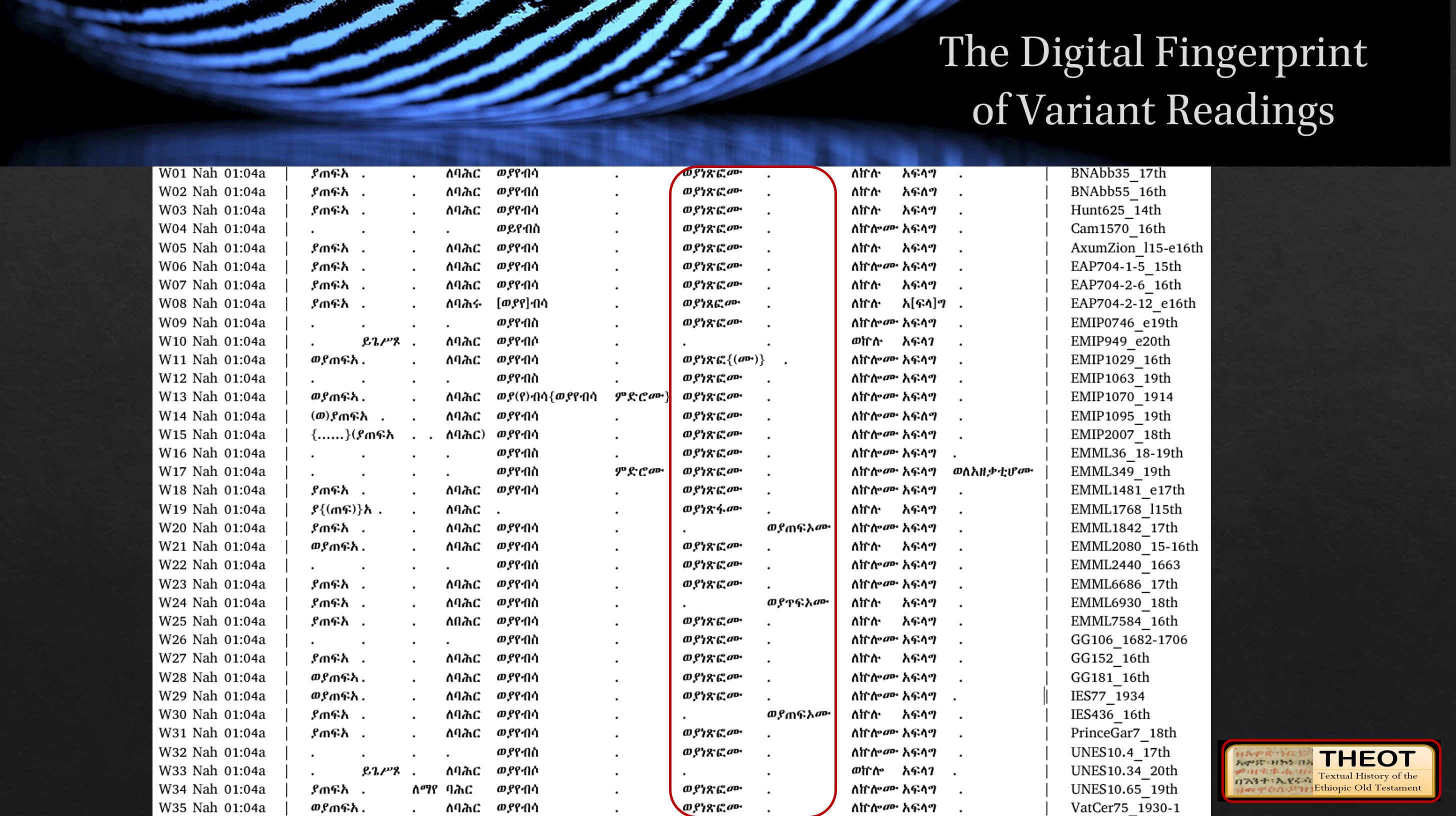
|
Variant Readings - A textual variant will express itself in at least two columns, usually—though not always—side by side. In this case, the difference is between those thirty of the thirty-four manuscripts whose readings are grounded on the root ነጸፈ “spread, spread out, strew, scatter, cover with carpets, make flat” (Leslau, 130), and those three of the thirty-four manuscripts whose readings are grounded on the word ጠፈአ “be extinguished, be put out (light), be blotted out, cease, be lost, perish, fail, disappear, vanish” (Leslau, 222). |
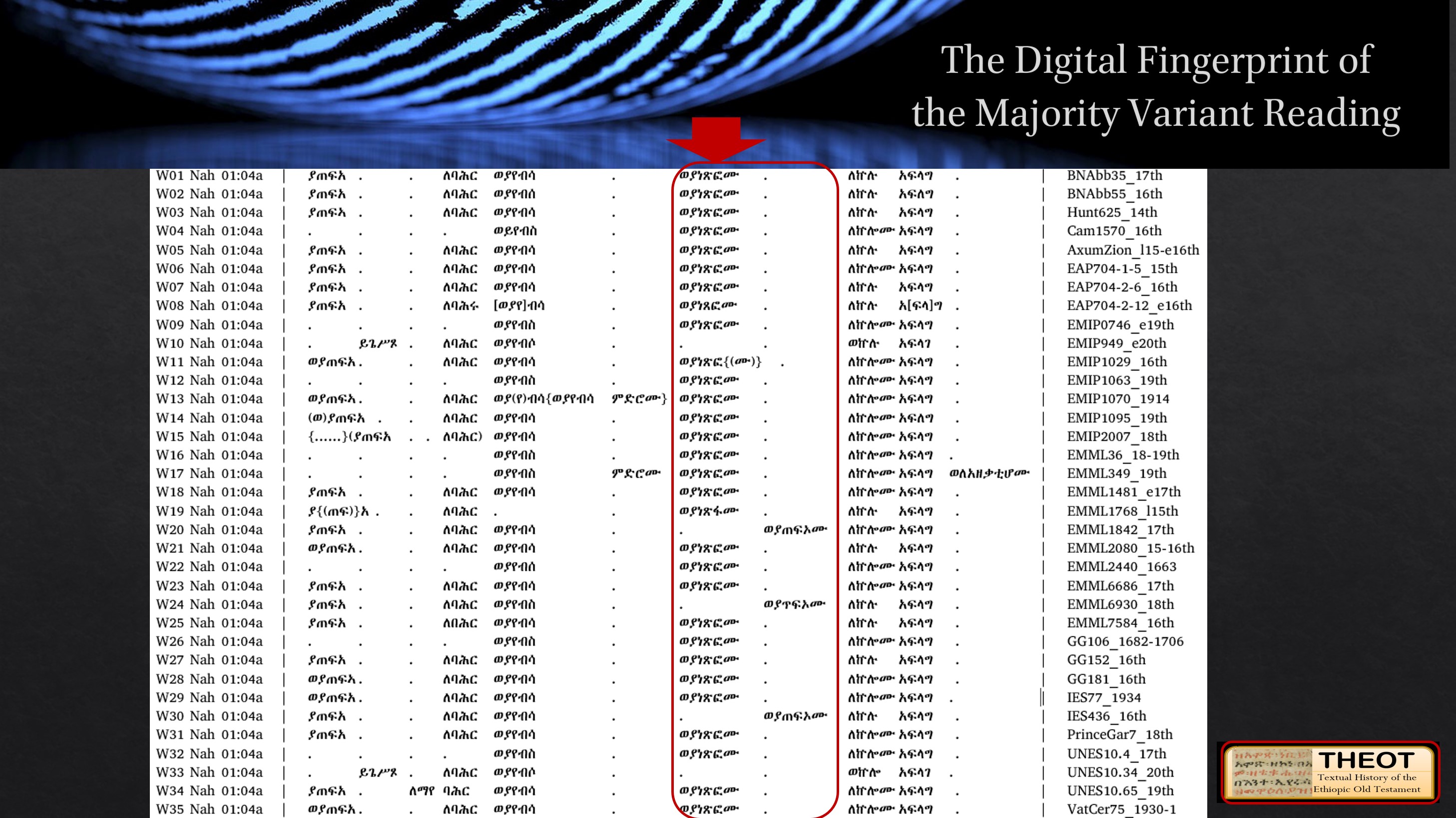
|
The Majority Variant Reading - Obviously, the column containing more manuscripts with the word present represents the majority reading. |
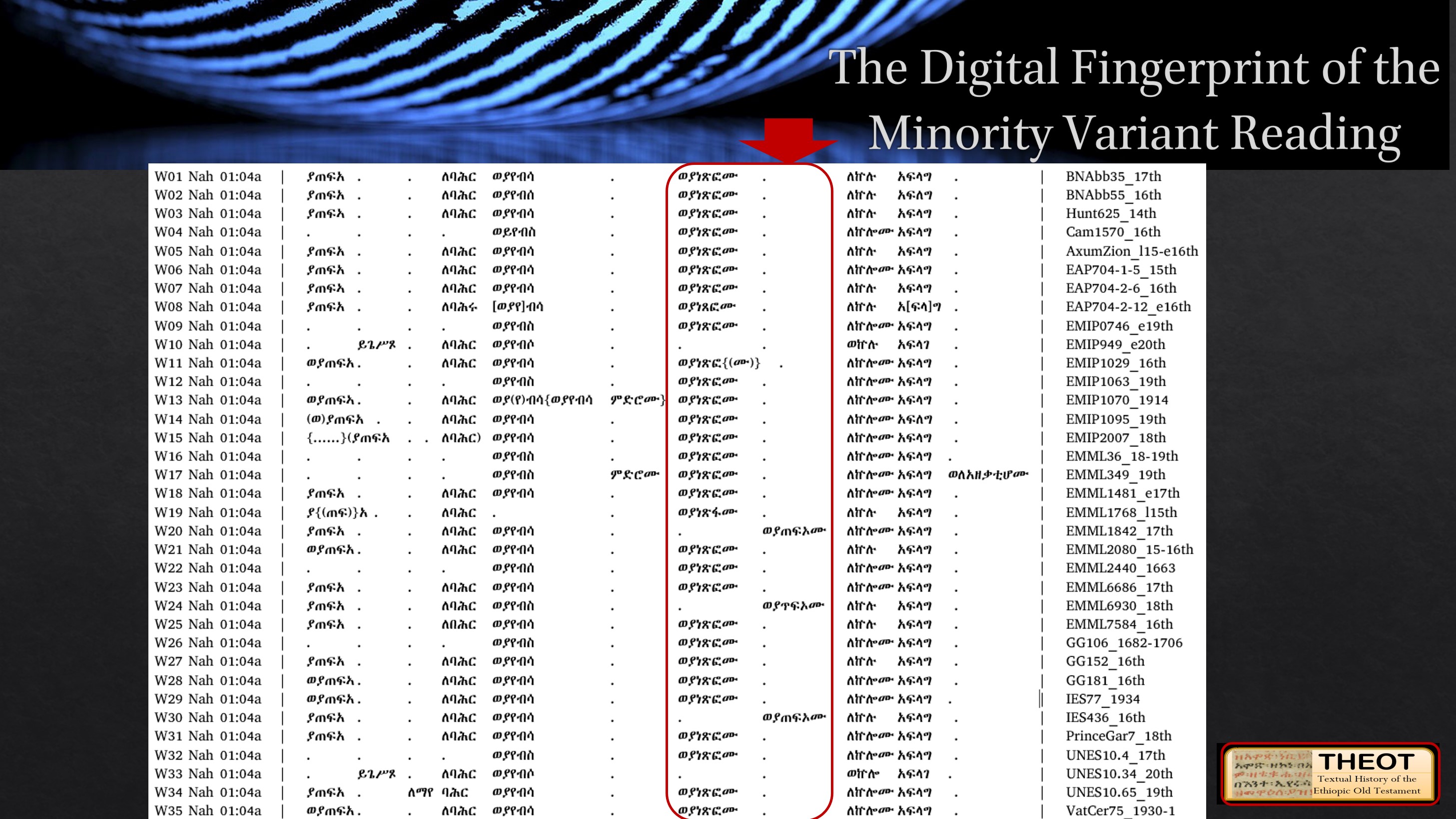
|
The Minority Variant Reading - And the column containing fewer manuscripts with the word present represents the minority reading. |

|
A +/- Variant - In contrast to the case of the idiosyncratic plus or minus, this variant is
characterized by a number of manuscripts that share a plus ኵሉ “all” over against the others which have
a minus (a dot, i.e., no word). In this case, there are three variants in the tradition. But, we will
only see them as we widen our understanding of the variation unit beyond this one column. Then we see
three variant readings:
|
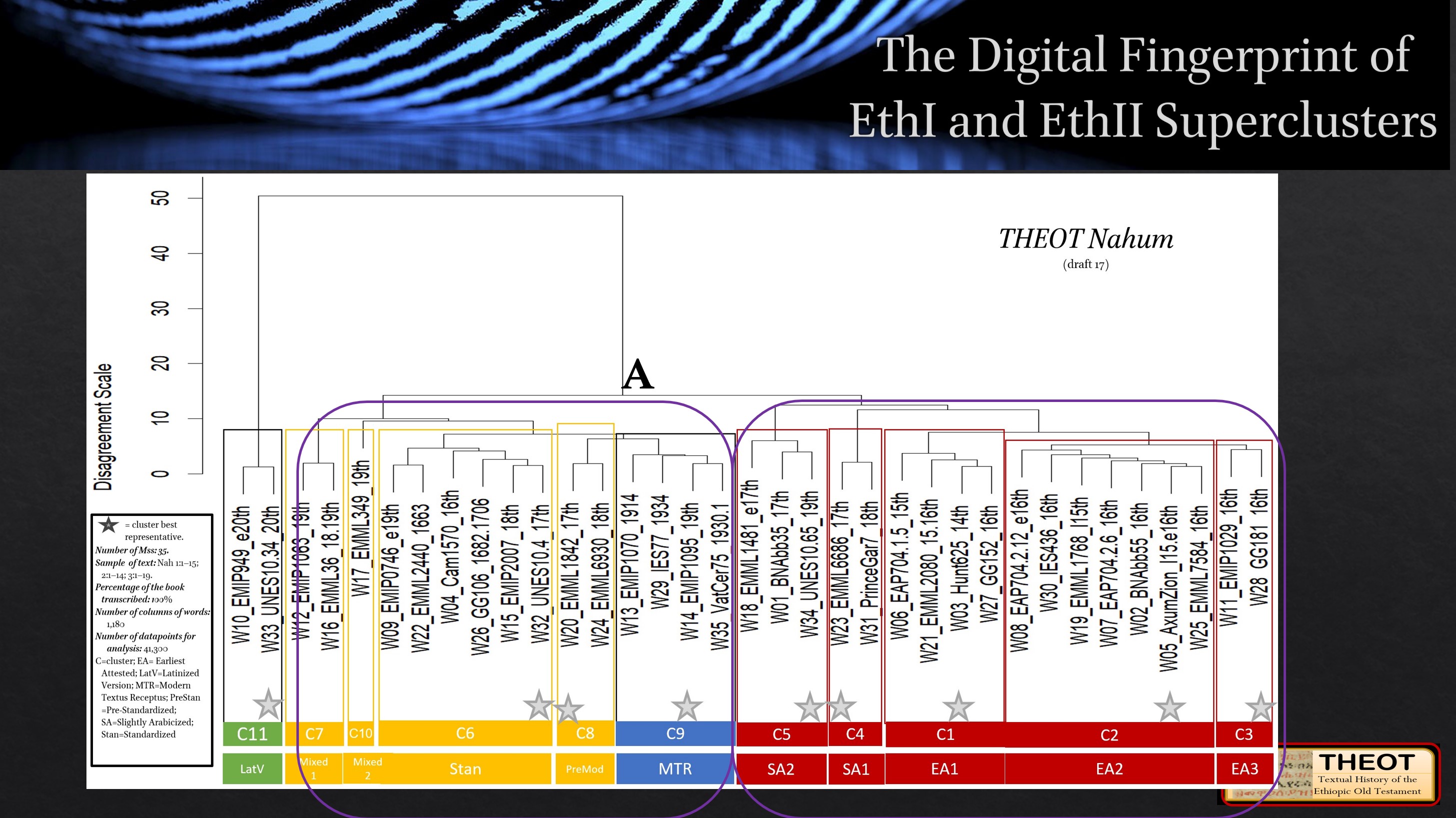
|
The Fingerprint of the two Major Clusters and Text Forms in the Dendrogram - The two boxes in purple surround the two superclusters in the tradition. At fork “A” in the dendrogram, they “separate” from each other at a degree of difference (the vertical axis) at about fourteen or fifteen percent. Eventually it will become clear that these represent the two major text forms in the tradition and that one of these is contained in manuscripts of the 14th to the 16th century (EthI) and the other is carried in the manuscripts of the 17th to the 20th century (EthII). |
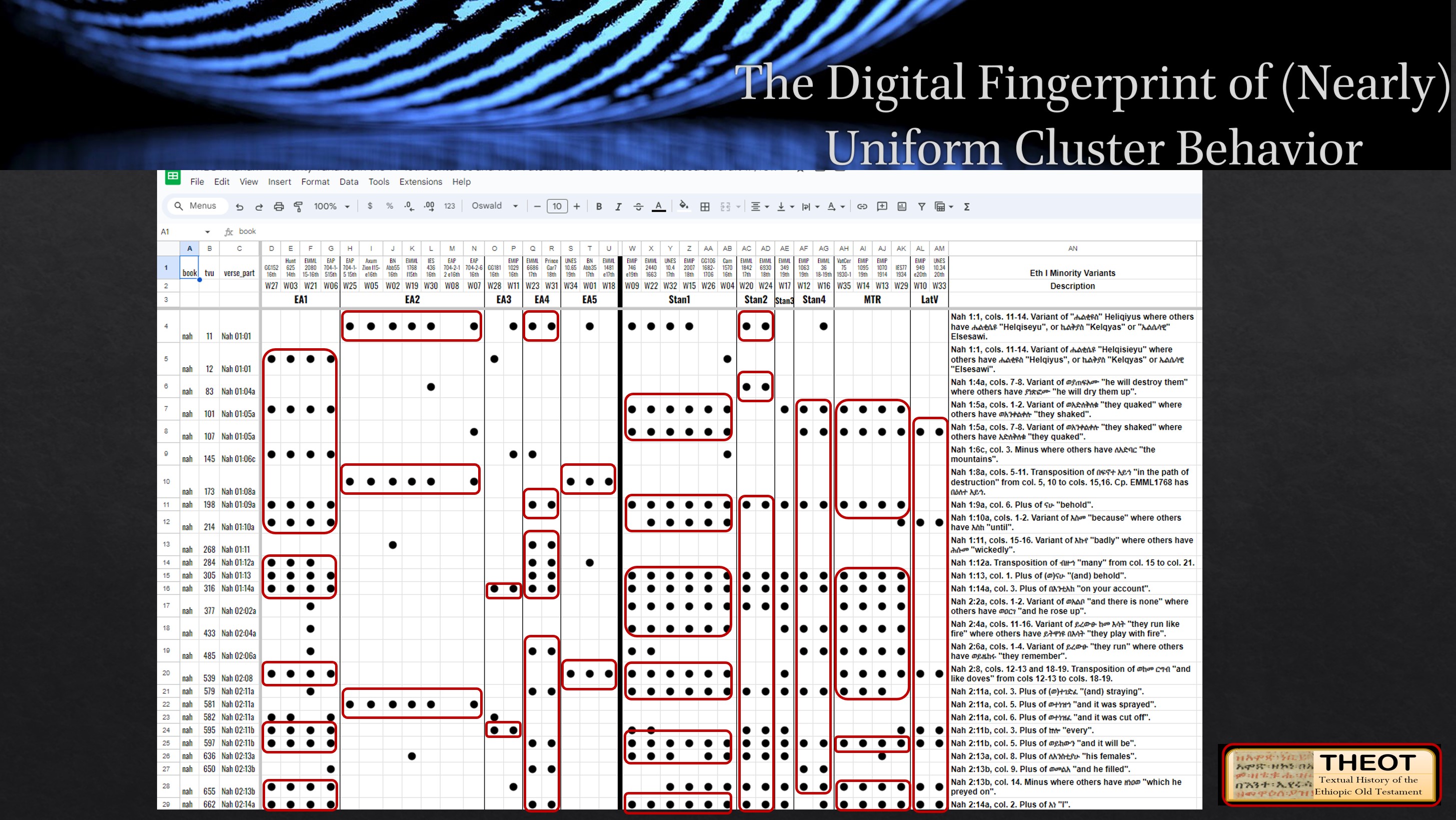
|
The Majority of EthI Minority Variants Occur as a Part of Uniform Cluster Behavior - This dataset shows all of the minority variants transmitted in manuscripts that carry the EthI text form. These are marked with dots in the columns labeled D through U. It also shows—in columns W through AM—whether or not the manuscripts of the EthII period perpetuate those minority variants from the EthI period. Perhaps the most dominant correlation we see, on first perusal, is that the distribution of the minority variants in the EthI period is concentrated in clusters that had these readings and stood over against the other EthI manuscripts. This is as opposed to a random distribution across all of the EthI manuscripts. It is worth reminding the reader that the dataset entitled Minority Variants in the EthI Period contains every case (that is, the data is exhaustive) in our sample of manuscripts and texts where the following conditions were met: 1) a variant reading exists among the EthI manuscripts at a certain point; 2) at least one less than half contain the minority reading; 3) but cases where only one manuscript contains a reading are not included since these are defined as scribal idiosyncrasy and are understood to be of a fundamentally different kind of activity, sociologically speaking. |
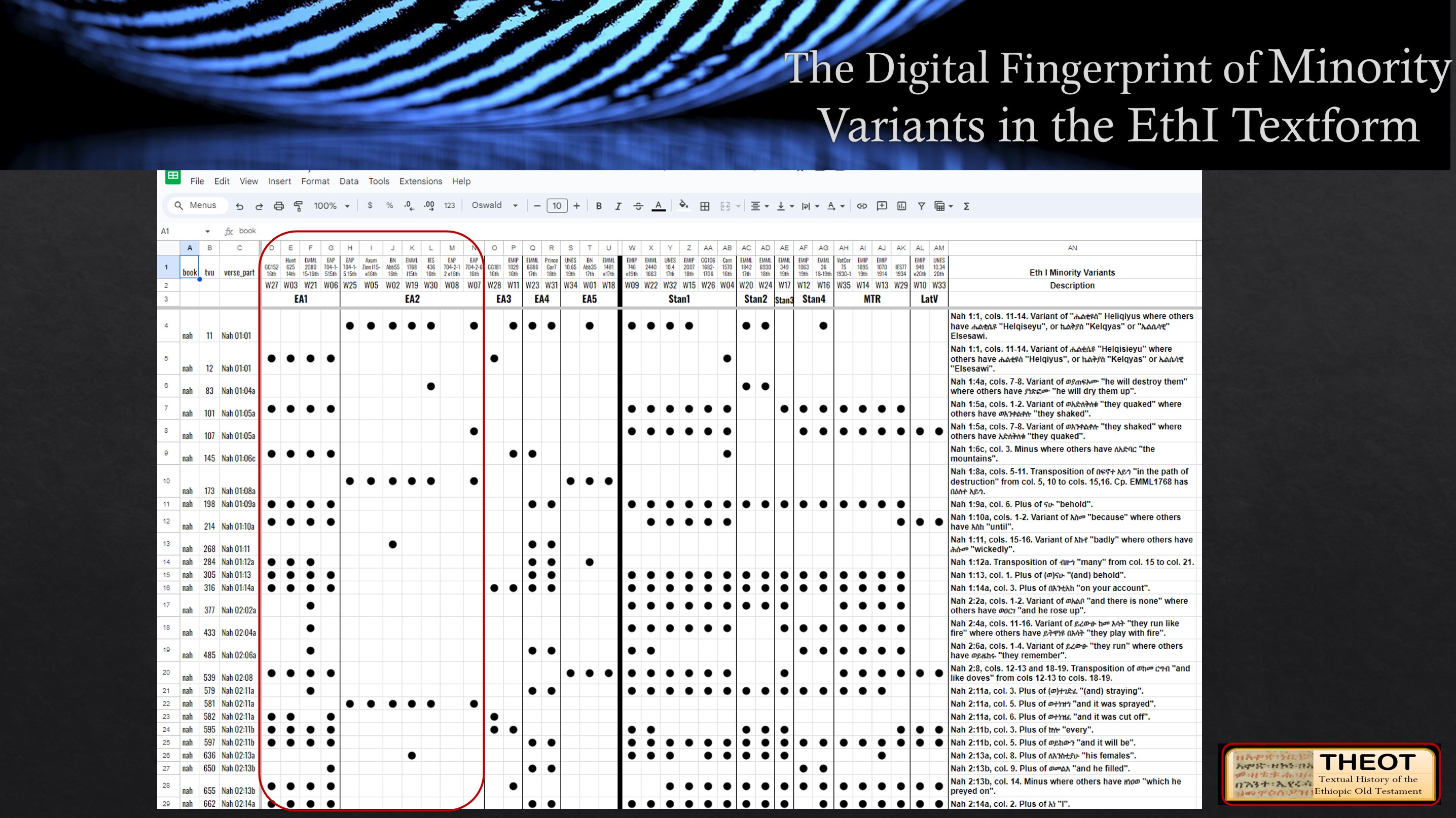
|
The Distribution of Minority Variants between the Manuscripts of EA1 and EA2 - The red box draws our attention to the two primary subclusters of the EthI Supercluster: EA1 and EA2. Both sets of manuscripts are from the 14-16th centuries. Above, we already made the first point – minority variants occur most frequently as part of uniform cluster behavior. Thus, demographically speaking, most of the concentration of minority variants occurs in the manuscripts of EA1 and EA2. Here, we must point out the limitations of our data. The clusters identified here as EA3, EA4, and EA5 are comprised of two or three manuscripts. With an N this small we cannot make sweeping claims about the behavior of the cluster. Further, the manuscripts of EA4 and EA5 are late copies of the EthI text form and, as such, behave in a way that is distinct to such late copies, as we will describe below. |
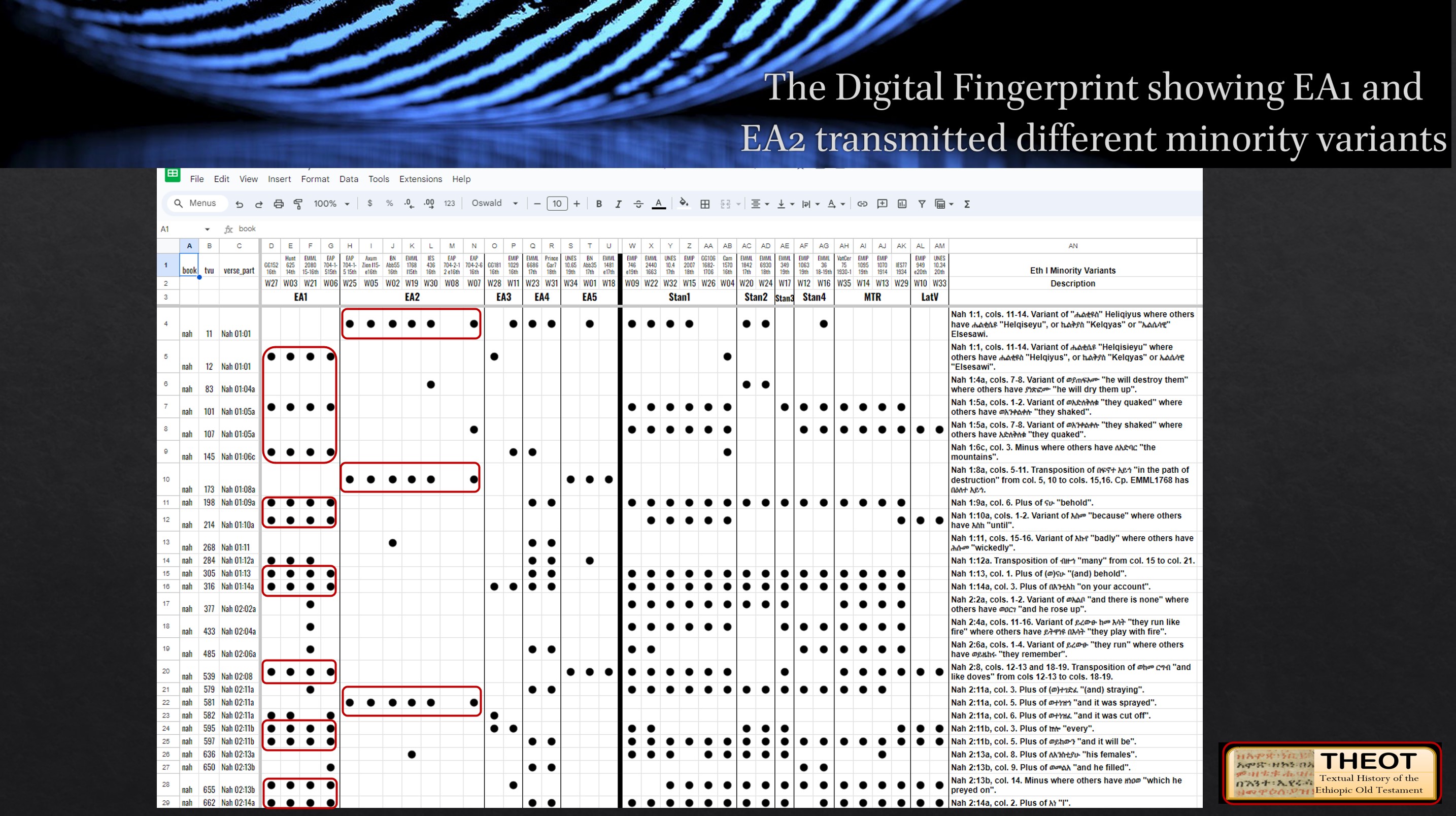
|
EA1 and EA2 Transmitted Different Minority Variants - One of the most significant finds of the project is that it is precisely these minority variants that play the greatest role in differentiating EA1 and EA2 from one another. On the one hand, EA1 and EA2 are alike in that:
Within their clusters they behave uniformity; but between the two clusters they represent two very-slightly-different text forms. Once again we point out that this difference is the central difference between the two clusters. |
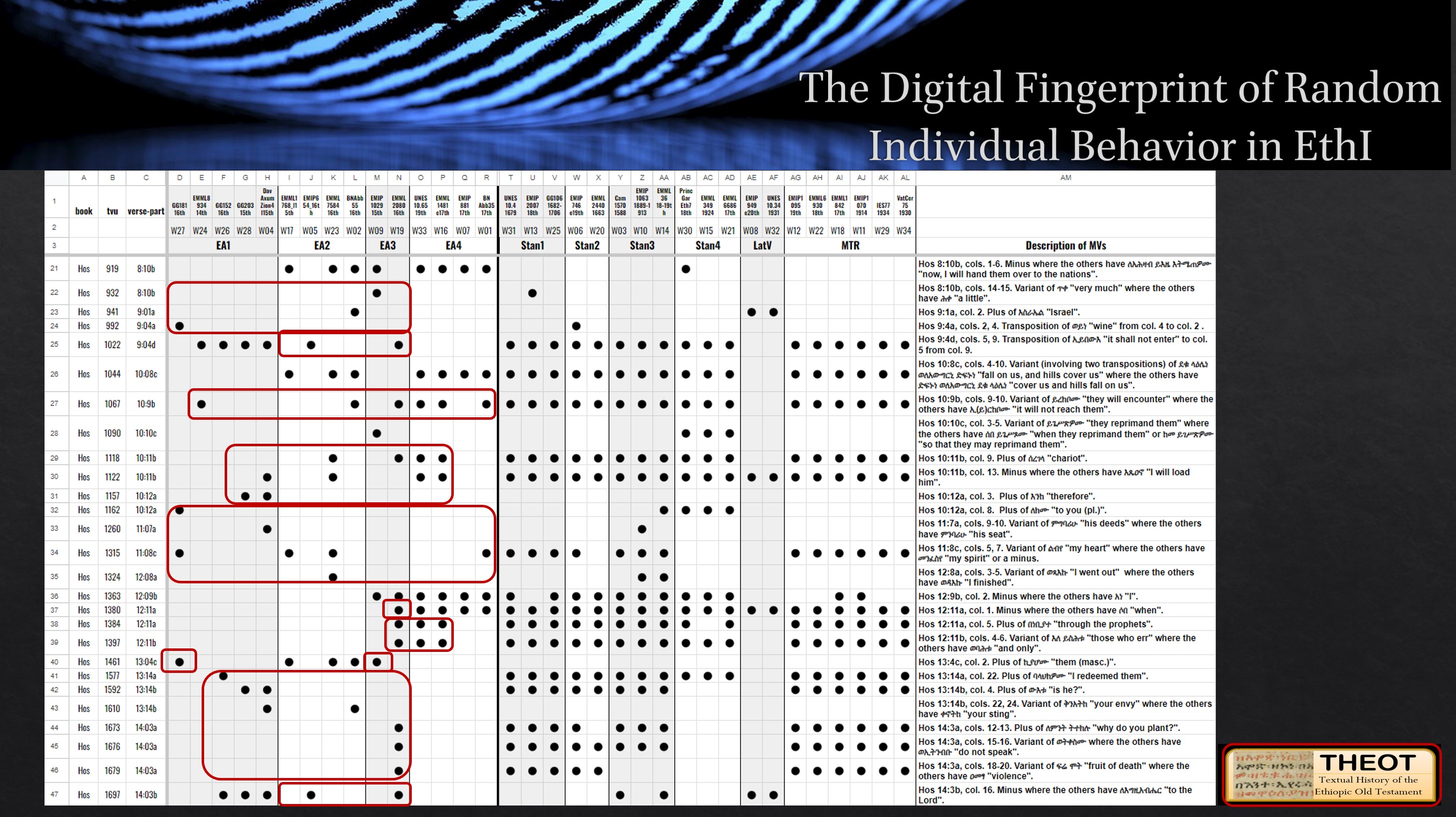
|
In Addition to Uniform Cluster Behavior we Can also Identify Random Individual Behavior in the EthI Tradition - Though the dominant expression of minority variants in the EthI period appears as a part of uniform cluster behavior, there are also many cases where minority variant readings appear seemingly randomly, as individual acts of individual scribes and not shared by all the other scribes in the cluster of which they are part. (In order to see the full range of data which substantiates this claim, see the full dataset on EthI Minority Variants in the Nahum Reports page or here EthI Minority Variants in Nahum). |
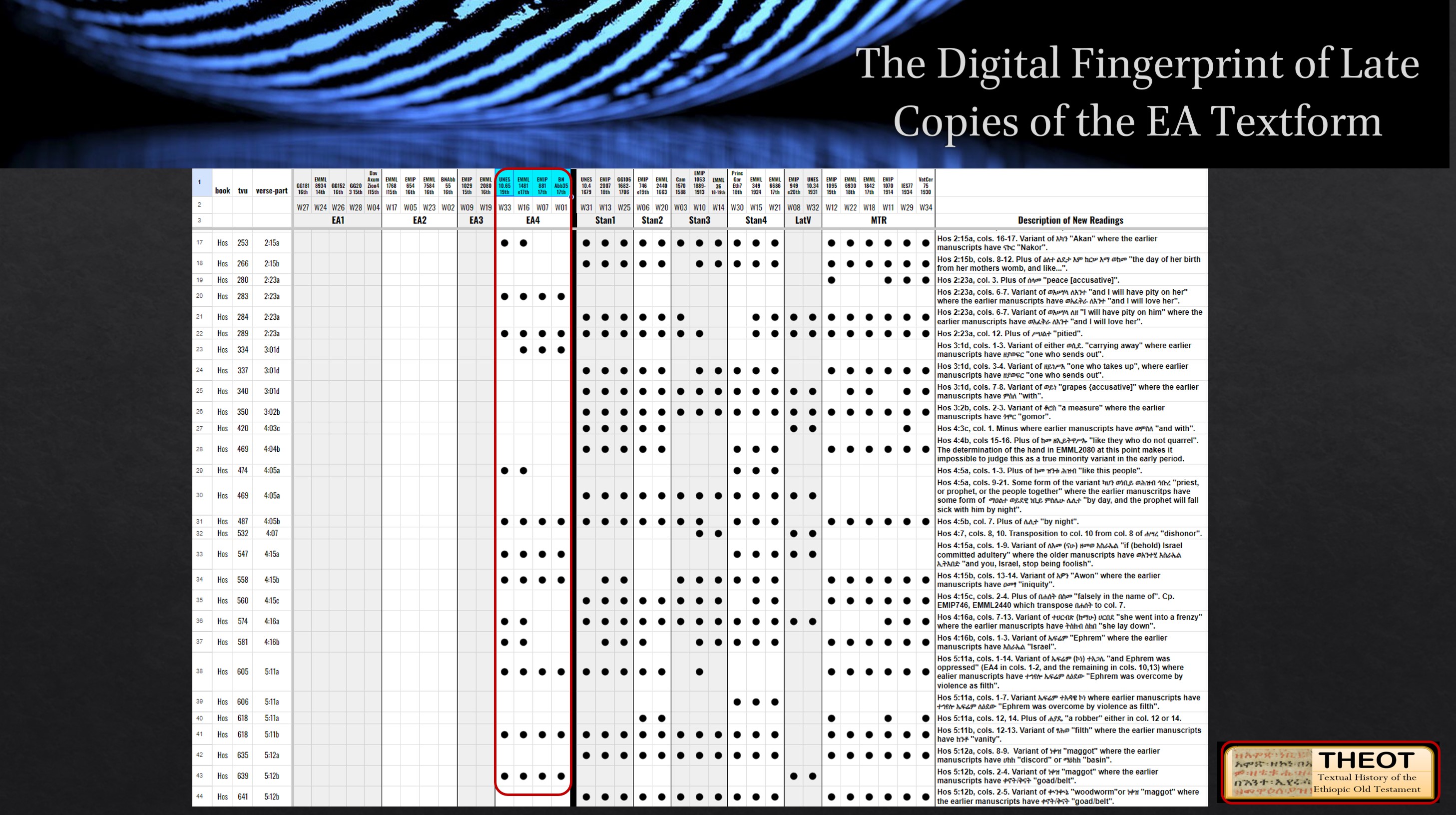
|
Late Copies of EAI Text Form Influenced by the EthII Milieu - From their chronology alone, we can see that some manuscripts that carry the EthI text form were not copied in the 14-16th centuries, but rather were copied in the 17-20th centuries. This documents the ongoing need and desire for the EthI text form, even after the EthII text form had become the dominant one being copied. But, one remarkable fact about these copies is that they carry readings that did not come into being until the 17th century. We explain this not as evidence that they were copied from old manuscripts that already had these readings. Our sample does not bear this out. Instead, it points to the likelihood that those copying the older text form in the 17-20th centuries did so under the pressure of the new text form that was dominant in their time and made concessions to its new readings. This is known as backward influence. |
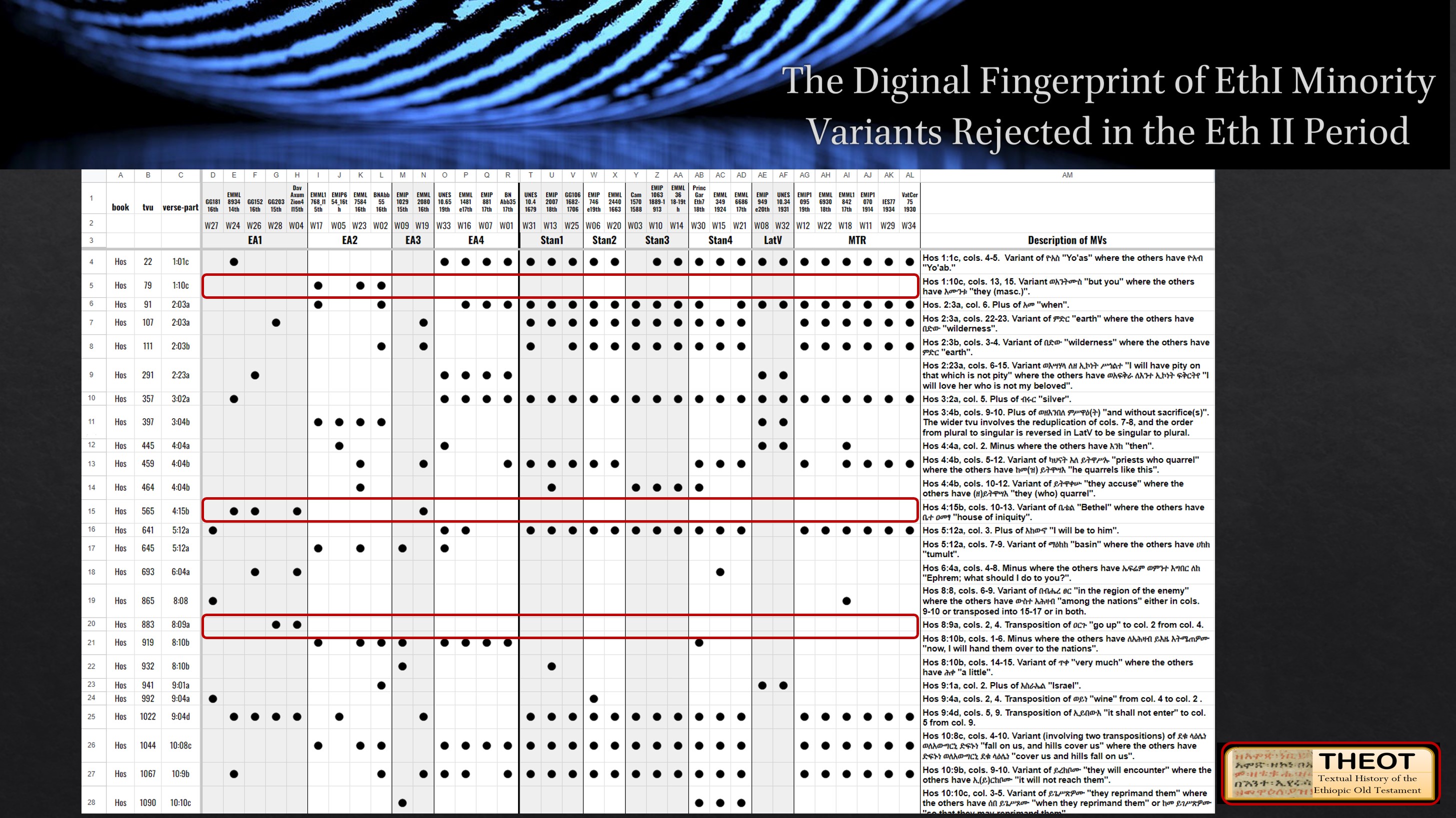
|
EthI Minority Variants Rejected in the Eth II Manuscripts - The majority of EthI Minority Variants were rejected by the framers of the Standardized text. At times the rejection rate of EthI minority variants was as high as 75 percent. This seems to make it clear that the matter of minority variants from past was one of the key editorial decisions made by the framers of the Standardized text. The majority were rejected. |
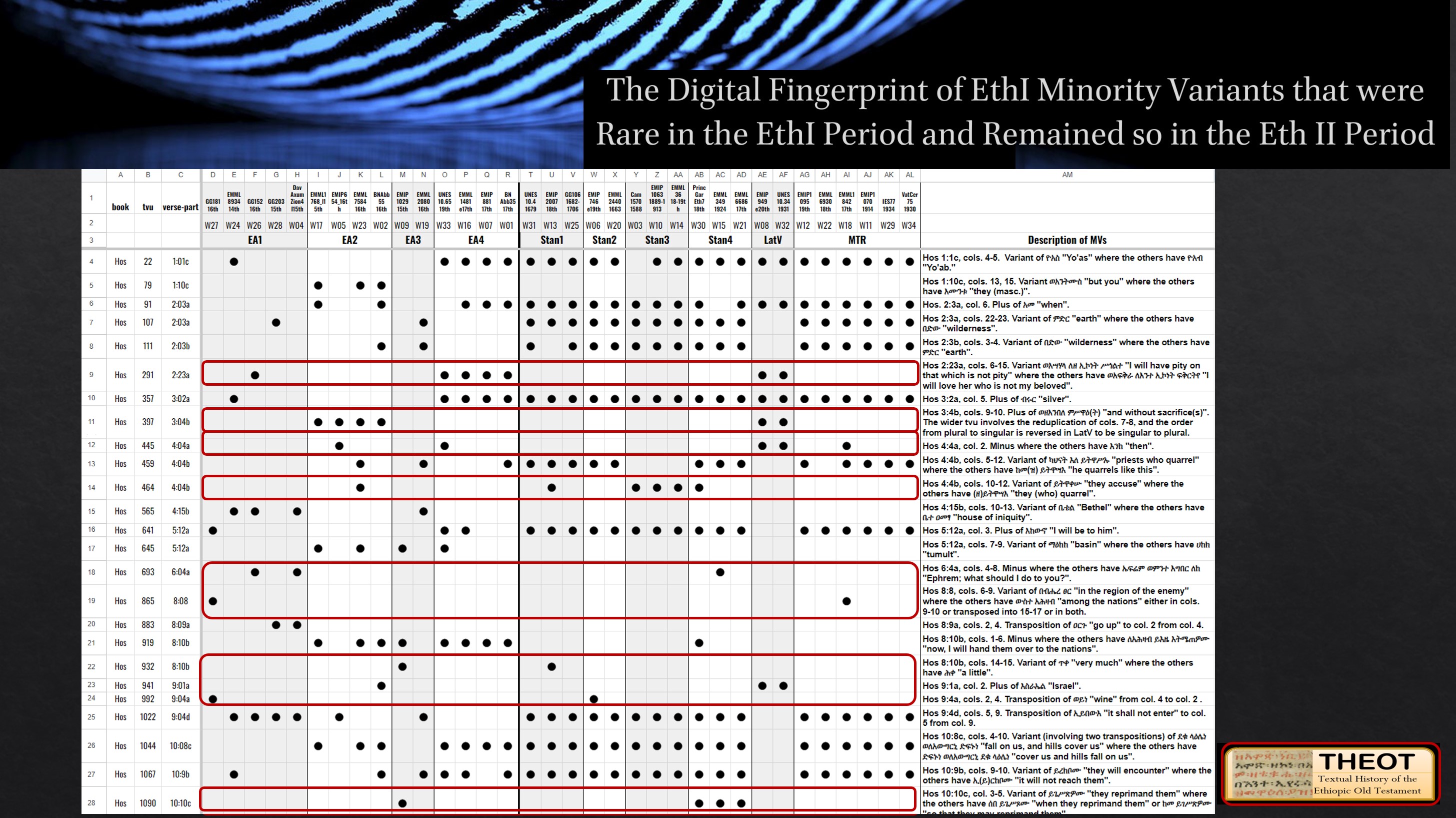
|
Other EthI Minority Variants that were Rare in the EthI Period Remained Rare in the Eth II Manuscripts - Another category of EthI Minority Variants were those that were 1) rare in the EthI manuscripts and 2) remained rare in the EthII manuscripts. These are enduring variants of the tradition, but ones that never captured the allegiance of the majority of the tradition. |
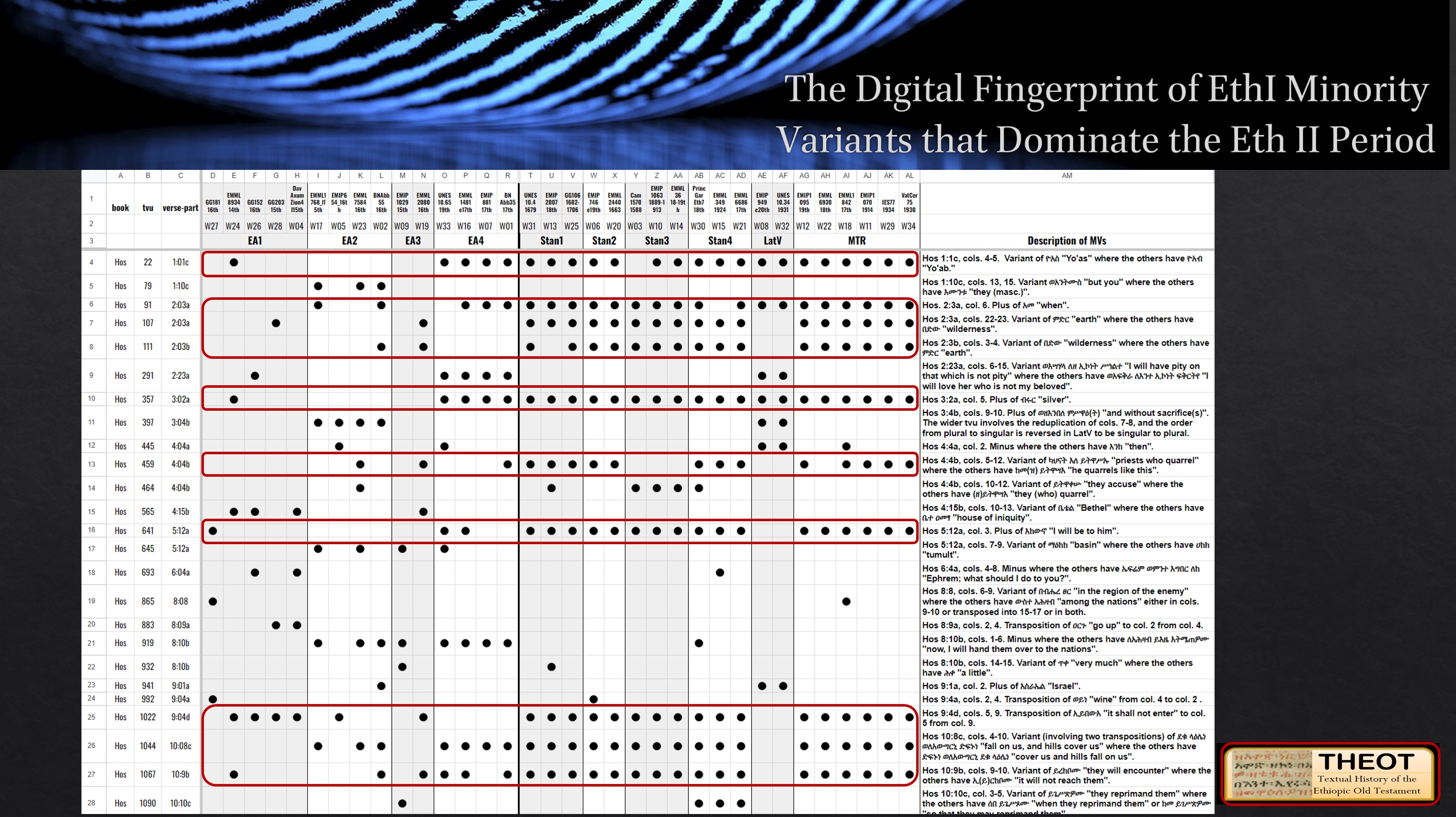
|
EthI Minority Variants that Came to Dominate the Eth II Manuscripts - Some of the EthI minority variants were elevated by the editors to become the main text of the Standardized text form. The degree to which the Stan/MTR clusters adopted the EthI minority variants became one of the primary mechanisms by which the EthII clusters are differentiated. Often the adoption of the elevated text was uniform across the EthII clusters. At other times almost all of the EthII manuscripts have the elevated reading, but a few clusters went with the old reading. |

